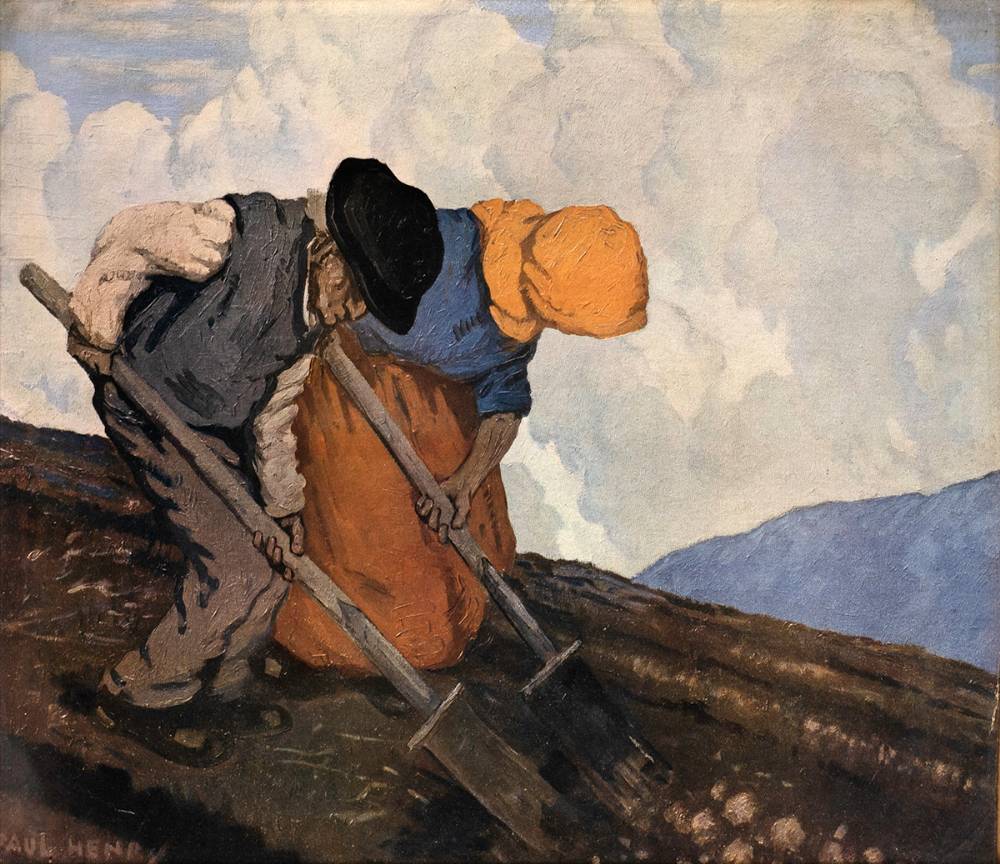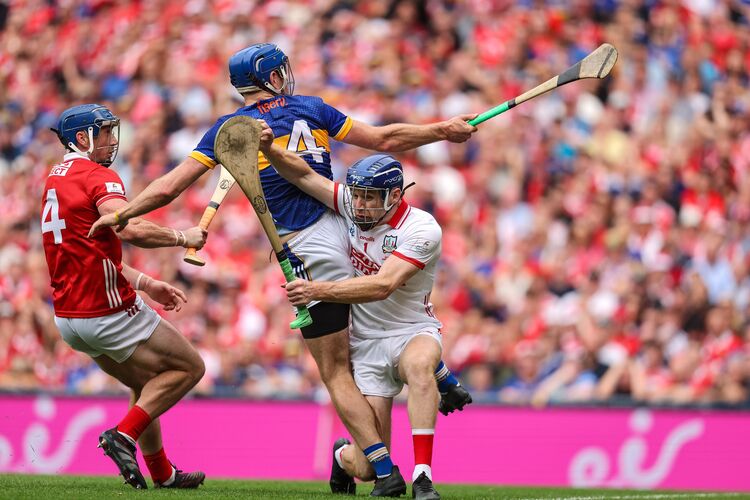Ironically, the artist who best captured the subtle and ephemeral beauty of the West of Ireland was an outsider. Belfast-born Paul Henry painted canvases that are regarded as the best canvases ever painted of the region. No artist influenced Irish and international perceptions of rural traditional life and the landscape more than he did. Earlier artists had painted Irish landscapes, but these scenes looked like paintings in England or France. Henry, on the contrary, created scenes so quintessentially Irish that they could be nowhere else, but the West of Ireland.
Henry’s work has become a cornerstone of Irish visual culture. In the 1920s his idyllic images of farmers and fishermen served as a kind of visual propaganda the newly formed Irish government to present the country as a pastoral paradise. For decades afterward, his iconic landscapes were reproduced on hundreds of thousands of posters by British travel agencies advertising Irish holidays and his paintings helped kick start the fledgling Irish tourist industry. Though he struggled for years to convince a skeptical art world of his greatness, today most critics regard him as the most influential Irish landscape painter of the 20th century. More than 60 years after his death, the Irish art world increasingly recognizes his genius, and the prices of his canvases continue to rise.
Henry’s father was a stern Baptist minister, who scorned the art world and raised the painter strictly, according to a fire and brimstone worldview. A prodigious child, Henry had already begun to draw before he entered kindergarten at Methodist College where his talent was first nurtured. He later transferred to the Royal Belfast Academical Institution. In June 1891 his father died, casting a huge cloud over his ambition to study art formally, but his close friend the portrait and miniature painter Thomas Bond Walker gave him free drawing lessons and taught him the elements of industrial design, which allowed Paul to be apprenticed to the Broadway Damask Co., Belfast, as a designer. After a couple of years, he left his job and joined the Belfast Government School of Art, where he studied under master painter, Alfred Rawlings Baker who specialized in “impressionist” portraits and genre scenes of country life.
Henry won the school's first prize for modelling from the antique and a second prize for drawing from life, but poverty threatened his burgeoning career. Fortunately, thanks to a cousin who promised to cover the costs of his education, Henry left Belfast for Paris where he studied at the Académie Julian under Jean-Paul Laurens. In Paris, Henry mastered the conventions of modern arts. Spending a lot of time in the Louvre, he became strongly influenced by the French Realist painter Jean Francois Millet, whose emphasis on nature and peasant life left a profound mark on Paul’s later paintings. Paul, however, would be even more profoundly influenced by American Winslow Homer, into whose Parisian academy he transferred. Henry learned how to use tone and subtle shades of color from Whistler, then honed those skills for 10 years while working almost exclusively in charcoal as an illustrator for London newspapers. While Studying under Homer, he met his future wife Grace Mitchell, an equally talented Irish painter. They married in 1903 and together, they formed a creative partnership, each influencing the other’s work in subtle yet significant ways.

The couple struggled financially in London until a 1910 holiday on Achill Island in County Mayo completely transformed their lives. The Belfast painter was so taken with the stunning beauty of the land and its unique light that he tore up his return ticket and announced to his shocked wife that he intended to remain and take up residence on the remote island.
Art historians credit him with invigorating Irish art by bringing the tools and techniques of the Post-Impressionist movement back from Paris. Henry at first decided to paint the people of Achill Island. Influenced by Millet, his scenes of daily life, whether it’s fishermen at sea or villagers gathering peat, reflect a deep love and respect for Ireland and its people. One of Henry's more famous paintings, ’”he Potato Diggers,” glorifies the hard manual labor of Achill islanders, but he slowly changed his focus from humans to nature. Painting Achill’s landscapes was an artistic challenge because of its unique light whose subtle tones and shades change fast and prove hard to capture on canvas. Henry, however, was up to the challenge. Applying paint thinly, evenly and precisely, Henry made a deliberate choice to focus on tone rather than color. He painted with a cool, muted palette of blues, browns, and earthy tones, which enhanced the solitary and earthy nature of his landscapes.
Henry did not simply copy nature; he subtly transformed it to heighten the effect of his paintings. He reduced complex natural shapes into clear, communicative forms, often using a simple arrangement of shapes. His canvases also feature a deliberate lack of foreground or background definition. He often over accented the dramatic Western skies with heavy masses of clouds creating the canvas’ mood. The landscape itself is often reduced to a narrow strip of earth at the bottom of the picture plane.
His paintings, which verge on the abstract, so skillfully caught the Irish countryside and rural life that they became a kind of blueprint for Irish painting. The Henrys left Achill in 1920 at a time when there was no distinctive Irish style and Ireland was trying to develop its own unique style of painting. Henry’s work filled that void. In the 1920s and 1930s, Henry became Ireland's most renowned artist, significantly shaping the popular image of the west of Ireland.
Though his paintings were popular with the public, the Irish academic community belittled his work and snubbed him, claiming his work was repetitive and lacked originality. The more conservative and traditional members of the Royal Hibernian Academy found fault with Henry’s post-impressionistic style, and they initially refused to accept him as one of its members. Irish newspapers also bitterly attacked his work. For many years, Henry could not even sell his iconic “Potato Diggers” canvas.
More disappointment followed. Grace and Paul broke up in 1924 and in 1953 Henry went totally blind and would never paint again. By the time he died in 1958, Henry's work had been imitated so often that it was considered cliché. The Irish wanted to think of themselves as a modern nation who had moved beyond the agrarian past depicted in his paintings. For a time, his work was out of favor, but a 2003 retrospective in the National Gallery in Dublin drew huge crowds and renewed interest in his work.
Today Henry’s works hang in the collections of the National Gallery of Ireland, Hugh Lane Gallery, Irish Museum of Modern Art, Ulster Museum, Victoria and Albert Museum in London, and the National Museum of Modern Art in Paris. ''Paul Henry, more than anybody, showed us how to look at the landscape,'' said Dr. S.B. Kennedy, who is also Henry's biographer. ''It's hard to go to the west of Ireland and not see it through his eyes.''







